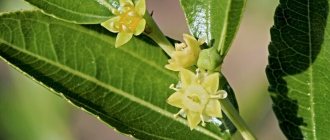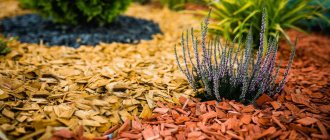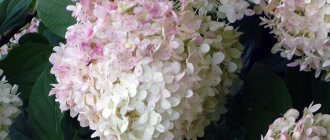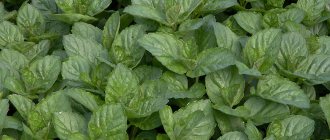Decorative garden plants
Planting ornamental shrubs can transform a former construction site or wasteland into a luxurious oasis in a few hours, if they were purchased in pots already grown. After purchase, they are replanted with a lump of earth.
In this case, all conditions regarding the characteristics of the soil and the degree of frost resistance should be taken into account. In view of this, you should choose those plants that will feel most comfortable on your site.
All trees and shrubs are divided into three types: beautifully flowering, evergreen and decorative deciduous garden plants.
Almost every person is familiar with such flowering ornamental shrubs as white acacia, perennial rose hips, and medicinal fragrant lilacs. Let's talk about other garden plants that have a more exotic appearance.
Strange plants of the world: description, photo
Strange plants of the world:
The strangest plants in the world - Momordica charantia
Momordica charantia is an annual herbaceous vine from the Cucurbitaceae family. This interesting plant is native to Asia. Depending on the place of growth, the name may change. Momordica is often called Chinese pumpkin, bitter cucumber, Indian pomegranate . The plant is unique in that during the ripening process it changes its taste.
When it is completely green, it has a taste similar to the cucumber we are used to. When half-ripe, the plant becomes bitter and begins to emit a pumpkin-like aroma. When it ripens, the flesh turns red and becomes sweet. At the moment, breeders have been able to develop varieties that produce fruit in our latitudes, although the plant feels best in a greenhouse.
The strangest plants in the world - Puya Raymonda
Puya Raymonda is a relative of the aromatic pineapple. The plant grows in mountainous areas because it loves cool weather. Moreover, it can easily tolerate sub-zero temperatures at night. Nature made sure that the plant easily tolerates adverse weather conditions. During the day, its pulp produces a substance similar in composition to antifreeze, and when the temperature drops below zero, it begins to act. Puya Raymonda is also unique in that it blooms once every 150 years.
Under favorable conditions, it can bloom even after 80 years. Its inflorescence consists of 10,000 flowers, which ultimately produce more than 11,000,000 small seeds. When the plant blooms, it looks like a flowering column with insects swarming around it.
The strangest plants in the world - Carnegia gigantea
Carnegia gigantea is a prominent representative of the cactus family. Grows in desert areas of Arizona and California. In nature, there are specimens whose height is more than 20 meters. These tree-like cacti live a fairly long life - at least 150 years. For approximately 100 years, the cactus grows in height, and only after reaching its maximum height does it begin to bloom and bear fruit.
And the closer the plant is to the source of moisture, the more fruits appear on it. If there is no source of moisture, Carnegia lives in saving mode. During the rainy period, it accumulates moisture in its pulp and then gradually uses it. People use cactus fruits for food, and dense needles instead of sewing needles.
Strange Plants of the World - Prickly Pear Bigelow
Prickly Pear Bigelow is another plant in the Cactus family. This “airy” representative of the flora from a distance resembles a fluffy bush, and only when approaching it can you understand that the plant is covered with not very large thorns. True, in nature there are also more massive representatives, reaching a height of up to 2 meters. They, accordingly, have larger spines - 2 cm.
When the cactus blooms, it becomes even more attractive. Its fluffy branches are covered with bright, red and green flowers. This species has also adapted to dry periods, and therefore accumulates moisture from the air during temperature changes.
Strange plants of the world - Porcupine tomato
Porcupine toma t is a prominent representative of Madagascar. True, this is not the plant that we grow in our garden plots. In Madagascar, it is considered a weed that can quickly grow over large areas. The most annoying thing for people is that it is not afraid of chemicals. After treatment, it fades only slightly, but literally within a day it resumes its growth.
Also, he is not particularly afraid of low temperatures. People have to fight it exclusively by eradication. But there are problems here too. The plant is covered with poisonous thorns, the poison of which causes allergies in humans. Therefore, most often it is first cut off closer to the root, and only then carefully removed from the site.
Rhododendron
These shrubs and trees are divided into deciduous, semi-deciduous and evergreen. According to various sources, this genus has more than a thousand species, including azaleas, popular among gardeners.
Literally, “rhododendron” is translated as “tree with roses” or “rose tree.” The reason for this name lies in the fact that azalea flowers look very much like roses.
This plant loves the climate of the coastal sea or river zone, therefore in the wild Rhododendron is most common in the south of China, the Himalayas, Japan and North America.
Some species can reach a height of more than three hundred centimeters, and the flowers vary in shape, size and color.
It blooms in large clusters of flowers that have an incredibly beautiful pink or purple hue.
Evergreens - a complete list with descriptions and recommendations from a gardenerVertical gardening - from idea to implementation, choosing options according to budget and attractiveness (photo + video)
- Vertical flower beds - basic principles and rules for choosing plants and arranging a suburban area with your own hands
It requires warm temperatures and therefore can freeze in winter. And only a few varieties are adapted to the climatic conditions of the middle zone.
Popular plants
- Zamioculcas (Dollar Tree)
- Kalanchoe
- Spathiphyllum
- Dracaena
- Poinsettia (Christmas Star)
- Cyclamen
- Poinsettia (Christmas star)
- Ficus benjamina
Sources
- https://glav-dacha.ru/komnatnye-cvety-katalog/
- https://WhatFlower.ru/houseplants/katalog-komnatnyx-rastenij-s-foto-i-nazvaniyami/
- https://zen.yandex.ru/media/id/5c151cc0330a1400aacd326f/samye-neprihotlivye-komnatnye-cvety-i-rasteniia-uhod-za-nimi-5c16b21b2fb96d00aa8d19e4
- https://rasteniya.dp.ua/ru/komnatnie-cveti/
- https://moyasotka.com/tsvety/komnatnye
- https://zen.yandex.ru/media/moiorhidei/14-neprihotlivyh-domashnih-rastenii-kotorye-mogut-cvesti-kruglyi-god-5d9da6771ee34f41895508c9
- https://uutvdome.ru/bol-komn-ras
- https://most-beauty.ru/nature/samye-krasivye-komnatnye-tsvety.html
- https://RoomFlower.ru/poleznoe/poleznye-komnatnye-rasteniya.html
- https://stroy-podskazka.ru/komnatnye-cvety/samye-populyarnye/
- https://agronom.guru/komnatnye-cvety-s-foto-i-ih-nazvaniyami
- https://rastenievod.com/category/komnatnye-rasteniya
[collapse]
Camellia
This evergreen garden plant belongs to the tea family, which includes more than eighty species of different plants. They were named in honor of the priest and naturalist G.K. Camelius, who first brought these plants from the Philippines to Europe.
This genus consists of compact evergreen shrubs and trees with simple glossy leaves that are ovate in shape.
The leaves come with pointed and blunt ends; they grow separately from each other in two or three pieces. Numerous stamens are pink, red or white
The plant needs careful care, and lack of light, high temperature, lack of humidity or an unsuitable soil mixture can cause the death of the flower.
Decorative grass - 140 photos of original design. Review of the best varieties of grass for the garden, instructions, reviews, videos + gardener recommendationsWatering the site - types and types of systems, main differences and features, rules for selection and installation, as well as recommendations for operation
Boxwood: planting, care, growing in open ground, propagation. Full description of the plant from A to Z. More than 100 photos of evergreen shrubs
Tamarisk
Another lovely ornamental plant, shown in the photo, is beautifully called Beadweed or God's tree. Tamarisk took its scientific name from the Tama Riz River, which flows in the Pyrenees Mountains.
Bisernik mainly grows in deserts and sand dunes. It can be found in Africa, Asia and southern Europe.
This tree has more than fifteen species, and in the Caucasus it rises to a height of over six hundred meters. Deciduous or evergreen shrubs grow in a bush-like manner, reaching a height of one and a half to twelve meters. Their trunk, as a rule, is no thicker than half a meter.
Its crown has many twig-like stems, on which small leaf blades that look like scales are alternately located. Their color can be light or dark green, as well as emerald blue.
Poisonous plants of the world: description, photo
Poisonous plants of the world:
Poisonous plants of the world - Common wolfberry
Common wolfberry - at first glance it may seem that these are just beautiful berries, some even try to taste them. The scientific name of this poisonous plant is Daphne. The shrub looks very attractive in appearance - dark green leaves and many red, juicy berries. The height of the plant can reach 2 m. The berries themselves are very poisonous, they provoke strong salivation, a burning sensation in the mouth and throat.
And when they enter the gastrointestinal tract, they provoke severe diarrhea, nausea, and vomiting. Literally 3 consumed berries can cause death. Even the juice from the berries is harmful to humans - it provokes burns and allergic reactions. If the juice is not quickly removed from the skin, ulcers may develop.
Poisonous plants of the world - Aconite
Aconite - at first glance in the photo, it’s just a beautiful wild flower, which was created to be admired. But those who live in the places where it grows know that it is better to bypass this beauty and not touch it at all. If you try to cut it or simply rub the leaves in your hands, you will thereby provoke an allergy on the skin. And this is the most harmless consequence that can be obtained from contact with this plant.
If its juice gets into an open wound or on mucous membranes, then very soon you will feel a headache, a burning sensation in the stomach and aching in the limbs . True, our ancestors still used the poisonous properties of the plant for their own purposes. They treated arrowheads with its juice, and this helped them paralyze the muscles of animals.
Poisonous Plants of the World - Crow's Eye
Crow's eye four-leaf is a plant that is very often used in folk medicine. Herbalists consider it an excellent remedy in the fight against various neoplasms. But as practice shows, people very often increase their dose of medication, and thereby worsen their condition. A large amount of toxic substances enter the body, and this causes seizures and headaches. Problems with the cardiovascular system may also occur , and this can be fatal.
Poisonous Plants of the World – Rosary Pea
Rosary pea is a very beautiful plant that people use to make decorative ornaments. To be more precise, beads, earrings and bracelets are made from it. Have you already imagined how beautiful it will all look? Before buying such dyes, weigh the pros and cons. Initially, picked peas are very poisonous. They contain abrin poison, which can kill a person in a short time.
Manufacturers of such jewelry claim that they process peas in a special way, which makes them safe for women. But as practice shows, even the special coating wears off over time, and the berries begin to gradually poison the body.
Poisonous plants of the world - Belladonna
Belladonna is another beautiful and at the same time poisonous plant. Many will say that this plant is widely used in medicine. Yes, for example, eye drops are made from it. But the dose of the active substance in them is so small that it cannot harm the body. But if you eat a couple of berries of this poisonous plant, you will probably be very poisoned.
If a small dose of toxic substances enters the body, you will end up with dry mouth and dizziness. If the dose is large, you may experience breathing problems, hallucinations, and very strong convulsions similar to an epileptic seizure. If such symptoms are present, it is necessary to urgently cleanse the stomach and carry out the most thorough cleansing of the entire body. If this is not done in time, death is possible.
Yew
This evergreen coniferous plant is great for the garden because it provides year-round greenery on the site. About eight species of trees and shrubs belonging to the Yew family are characterized by rather slow growth.
This crop is in particular demand among gardeners who use coniferous plants in landscape design.
Living fence - the best ideas on what to make a hedge from at your summer cottage. Many photos of ready-made options with exclusive designs + instructions- Trimming bushes - the basics of choosing the right plants and forming the right shapes, selecting tools (photo + video)
Landscaping a site - basic principles and rules for creating a beautiful site with your own hands
Despite the fact that yew is an unpretentious and highly ornamental plant, year after year it becomes less and less in natural conditions.
Yew has a red-brown scaly bark, a multi-vertex cylindrical crown, and dark green soft needles. Thanks to its valuable wood with antibacterial properties, the plant is listed in the Red Book.
Decorative indoor plants
Growing beautifully flowering plants in pots began to be practiced back in the era of the Great Geographical Discoveries. Today, caring for indoor plants is a passion for millions of people around the world.
Flowers vary in shape, color and foliage characteristics and may be of local or distant origin. In any case, in the bustle of the city, they remind you of the enchanting delights of nature.
Balsam
This decorative flower is incredibly popular due to its unpretentiousness, almost constant flowering and easy propagation.
People call it affectionately the sparkle, impatiens or evergreen. Having appeared in Europe at the beginning of the 16th century, it was subsequently quite quickly spread throughout the world.
Its branched, succulent stems, depending on the variety, reach a height of fifteen to fifty centimeters. And the fleshy leaves with wavy edges are green-red, green or bronze in color.
Exotic flora: 25 amazing plants
The nature of the World is rich, diverse and amazing. Each continent is filled with extraordinary representatives of the flora, which amaze us with their beauty and unique properties.
I propose to get acquainted with the most prominent representatives of exotic plants.
Exotic flora, Pachira
Pachira
the homeland of pachira . Under natural growing conditions, some species of this plant can be found in the jungles of South and Central America.
Currently, this plant has become very popular in indoor floriculture around the world. However, in indoor conditions pachira almost never blooms.
According to Feng Shui theory, pachira endows household members with health, luck, wealth and prosperity. With the appearance of this plant in the house, positive energy increases, and negative energy sharply weakens, which creates a friendly environment in the family.
Exotic flora, Pachira
Exotic flora, Cavendish (cavendishia grandifolia)
Cavendishia (cavendishia grandifolia)
A low-growing shrub of the heather family, common in the mountainous regions of tropical America.
The genus is named after Lord William George Spencer Cavendish (1790-1858), president of the Royal Horticultural Society of London.
According to The Plant List database, the genus includes 113 species, many of which are epiphytes.
Exotic flora, Cavendish (cavendishia grandifolia)
Exotic flora, Passionflower (Passiflora)
Passiflora
Passionflower - aka passion flower... aka granadilla or just passion fruit.
The name Passiflora comes from the Latin words “passio” - suffering and “flos” (Russian name for “passion flower”). The plant owes this name to the religious figure Giacomo Bosio, who in 1610 described the passionflower as a visual embodiment of the Passion of Christ. The three stigmas of the pestle symbolized the nails with which the feet and hands of Christ were nailed to the cross. The outer crown represented the crown of thorns, the stamens represented the five wounds. The seventy-two coronal threads of the inner crown were taken to be the number of thorns of the crown of thorns. The spear-shaped leaves symbolized the spear that pierced Christ. The pieces of iron found on the reverse side of the sheet were supposed to represent the thirty pieces of silver that Judas received for his betrayal.
There are about 500 species of passion flowers. They mainly live in Brazil and Peru, some in tropical Asia, Australia and one species in Madagascar.
Exotic flora, Passionflower (Passiflora)
Exotic flora, Passionflower (Passiflora)
Exotic flora, Strongylodon macrobotrys
Strongylodon macrobotrys.
The amazing jade flower is rightfully considered one of the most original and unique plants in the whole world. This evergreen vine of the Legume family prefers to live in tropical forests in Hawaii and the Philippine Islands, reaching a length of up to 20 meters.
Incredibly beautiful inflorescences attract with their beauty during the day, and fascinate at night, as with the onset of darkness they begin to glow, thereby increasing their popularity among tourists.
Unfortunately, this amazing plant is on the verge of extinction and is included in the world list of flowers that need protection.
Exotic flora, Strongylodon macrobotrys
Exotic flora, Strongylodon macrobotrys
Exotic flora, Erythrina
Erythrina
Tree of the legume family. It is also called Coral Tree or Cockscomb .
Bizarre coral inflorescences, reminiscent of rooster spurs or cockatoo crests, shower the entire plant with bright lights. Translated from Greek, "erythrina" means red, although some species have flowers in shades of orange, yellow, cream, white and even greenish. The corollas of the inflorescences are rich in nectar, dripping like rain. Perhaps that is why in different parts of the world the plant is called the tree with the tears of a child.
The wood of the plant is porous, light and buoyant. Therefore, Pacific Islanders use Erythrina in the manufacture of surfboards, musical instruments and orthopedics.
The seeds of all species of this plant are poisonous. They contain the alkaloid erythroidine, the effect of which on the human body is equivalent to the poison curare.
Exotic flora, Erythrina
Exotic flora, Etlíngera
Etlingera
Or flowering ginger, a perennial herbaceous plant of the Zingiberaceae family, named after the German botanist and physician Ernest Etlinger.
This plant is one of the most beautiful and spectacular. It is called Emperor's Torch, Flame Lily, Torch Ginger, Porcelain Rose, Philippine Wax Flower.
This perennial herbaceous beautifully flowering plant is native to Southeast Asia. It consists of numerous clusters of vertically growing stems, with large and dense leaves. Blooms in the warmer months with large, showy flowers in shades of red, pink and white.
The main habitat of Etlingers is warm countries near the equator. In Russia you can only find it in the southernmost places or greenhouses.
Exotic flora, Etlíngera
Exotic flora, Etlíngera
Exotic flora, Couroupita guianensis
Couroupita guianensis
A very interesting tree native to South America. Otherwise known as the “cannonball tree.”
The height of the plant reaches 35 meters. Long brushes descend straight from the trunk. During the flowering period, incredibly beautiful wax flowers bloom on them. They are pollinated by bats.
After flowering, the tree produces unremarkable fruits. After eight to nine months, they increase significantly in size (up to 20 cm in diameter) and become like “cannon balls.” When ripe, the fruits fall to the ground with such a roar as if a volley from a cannon was heard.
Exotic flora, Couroupita guianensis
The fruit exudes pulp with many seeds. It is completely edible for animals and is used in veterinary medicine (it is used to rub dogs against scabies).
Kurupita flowers are used in cosmetics due to their wonderful scent. And some parts of the tree are used as an anti-inflammatory and antifungal agent.
Walnut shells are used to make excellent household utensils.
Exotic flora, Couroupita guianensis
Exotic flora, Couroupita guianensis
Exotic flora, Tacca Chantrieri
Tacca Chantrieri
This rare, charismatic plant is native to the rainforests of Southeast Asia. It is NOT an orchid or lily, although it has similar flowers and grows in similar conditions.
What does this flower remind you of? Bat silhouette? The mouth of a wild animal or an exotic butterfly?
Takka Chantrier , black lily or devil's flower... Many legends and even superstitions are associated with this plant.
The natives made various potions and ointments from its roots and fruits. In Europe, amateur mystics brewed insidious love potions from dried flowers.
Exotic flora, Tacca Chantrieri
Exotic flora, Tacca Chantrieri
Exotic flora, Heliconia
Heliconia
Heliconias are American relatives of the African strelitzia and the cultivated banana (I’ll talk about them a little later).
This herbaceous plant grows in the tropical forests of South America and the mountainous coasts of Southeast Asia. Due to the unusual shape of the flowers, heliconias are called “lobster claw” or “parrot flower”, due to the variegation of colors. And travelers describing the tropical rainforest mention garlands of brilliant purple flowers hanging above their heads, looking like blades covered in blood.
Today, there are at least 230 species and many hybrids of these amazing plants.
Exotic flora, Heliconia
Exotic flora, Heliconia
Exotic flora, Gloriosa
Gloriosa
These are climbing herbaceous evergreens. Because of its beauty, the plant is sometimes called flame lily .
As often happens in nature, Gloriosa has absorbed two opposing properties: an attractive appearance that attracts people to touch the flowers and toxicity - an implicit danger to the life and health of humans and animals. However, not everything is so scary... you just need to know the peculiarities of growing gloriosa and the rules for safe handling of it.
Exotic flora, Gloriosa
Exotic flora, Gloriosa
Exotic flora, Psychotria elata
Psychotria elata
Charming Psychotria grows in the countries of Central and South America (Colombia, Costa Rica, Ecuador and Panama). Like any true woman, she is very whimsical and capricious, prefers very delicate weather conditions.
Red “lip petals”, contrary to popular belief, are not a flower. This is a bract - modified leaves of a plant. They serve to attract pollinators - hummingbirds and butterflies. After the pollination process, the once bright and alluring “sponges” very quickly lose their attractiveness and fade into the background so as not to interfere with the formation of fruits.
Currently, due to uncontrolled deforestation of tropical forests, the Enchantress Psychotria is difficult to find in her natural habitat. It is on the Red Book list of endangered species. Efforts to preserve it are of course being made, but in reality this is very difficult and expensive to implement. In a word, perhaps soon kissing beauties will cease to exist, leaving beautiful photos as memories for us.
Exotic flora, Psychotria elata
Exotic flora, Strelitzia
Strelitzia
with Strelitzia for a long time now. This is a very bright and unusual tropical plant, the peculiar flowers of which resemble strange birds.
Strelitzia its name in honor of Sophia Charlotte of Mecklenburg-Strelitz (wife of the English King George Ⅲ).
The homeland of this exotic flower is South Africa (where it is called crane flower). But, thanks to its beauty, the plant has spread to many corners of the world, and in Los Angeles it is so popular that it was proposed to place an image of the flower on the city’s coat of arms.
The juice of the leaves and stems of Strelitzia is toxic, therefore, it is recommended to keep children and animals away from it. At the same time, this plant is widely used in herbal medicine and cosmetology.
Exotic flora, Strelitzia
Exotic flora, Eucalyptus (Eucalyptus)
Eucalyptus (Eucalyptus)
We are also very familiar with eucalyptus These are evergreen trees that can grow up to 100 m in height. It grows in the forests of Australia, New Zealand, Indonesia, New Guinea and the Philippines. There are more than 700 species of these trees in the world.
Eucalyptus is rightly called a living factory of phytoncides. Its volatile compounds have a detrimental effect on pathogenic microorganisms: staphylococci, streptococci, typhoid bacillus, Trichomonas, dysentery bacillus and many others. Inhalations with the addition of eucalyptus oil help ease breathing, soften and remove mucus.
Exotic flora, Eucalyptus (Eucalyptus)
Exotic flora, Eucalyptus (Eucalyptus)
Exotic flora, Amorphophallus titanum (Amorphophallus titanum)
Amorphophallus titanum
Amorphophallus Titanium is native to the tropics of the Indonesian island of Sumarta. It grows in South Africa, Vietnam, India, the Pacific Islands, Madagascar and, curiously, in polluted places.
The height of this plant reaches two and a half meters, and its weight is 75 kg. Commonly it is called “Snake Palm”, “Voodoo Lily”, “Devil’s Tongue”, and because of its unpleasant smell, “Corpse Scent”.
This plant lives for about 40 years, but it can only bloom 3 times.
The underground part of the giant is a tuber weighing up to 50 kg. It is actively used in cooking, especially popular in Japan. Tubers are added to both first and second courses; they are used to make flour for the production of homemade pasta. It is believed that dishes with this plant help eliminate allergies, remove waste and toxins and promote weight loss.
Exotic flora, Amorphophallus titanum (Amorphophallus titanum)
Exotic flora, Amorphophallus titanum (Amorphophallus titanum)
Exotic flora, Rafflesia arnoldii (Rafflesia arnóldii)
Rafflesia arnoldii
This is another representative of the flora of the island of Sumatra. It can also be found on the island of Kilimantan and in Southeast Asia.
Like Amorphophallus titanium, Rafflesia Arnoldi has a strong carrion scent. For this she was nicknamed the corpse lily. The diameter of the flower can reach one and a half meters.
This plant is a parasite in the truest sense of the word. She chooses tropical vines as her host. Once on the bark of the vines (through the migration of animals and gusts of wind), the seeds of the plant begin to slowly develop. Ripening occurs within 9-10 months, and then bud formation takes place for another 3-5 months.
The Rafflesia Arnoldi flower has neither roots nor leaves. The roots are replaced by a comb thread. It is thanks to her that the flower feeds, receiving all the necessary minerals and salts from the vine. The average weight of a flower is 9 kg (the largest specimen reached 11 kg).
By the way, such sabotage does not bring much harm to the vine.
Exotic flora, Rafflesia arnoldii (Rafflesia arnóldii)
Exotic flora, Rafflesia arnoldii (Rafflesia arnóldii)
Exotic flora, Puya berteroniana
Puya berteroniana
The incredibly beautiful plant Puya Berteroni belongs to the Bromeliad family and is found only in the mountains of Chile. The height of the plant reaches 90-120 cm.
This exotic plant can easily claim the title of queen of the garden. Its amazing flowers of a unique silver-green-bluish hue reach 5 centimeters in width, with bright orange anthers located in the center, creating a spectacular contrast with the petals.
Exotic flora, Puya berteroniana
Exotic flora, Puya berteroniana
Exotic flora, Puya berteroniana
Exotic flora, Banksia
Banksia
Australian beauty Banksia. Its amazingly shaped inflorescences resemble large fluffy candles that can contain up to four thousand small tubular flowers.
The plant owes its name to the botanist Joseph Banks, who accompanied James Cook on the first expedition and collected a large collection of specimens of Australian plants.
The plant is extremely hardy and unpretentious. With the onset of dusk, Banksia intensely release essential oils, attracting insects, birds and small rodents that pollinate the plant.
It is noteworthy that banksia with the help of fires! The seed capsule is so dense that it bursts only under the influence of high temperatures. Therefore, banksias always wait for steppe fires to release their seeds.
Now the Australian beauty can be found outside her homeland. Because of their attractive appearance, they began to be grown in gardens and greenhouses, and dwarf varieties were bred for indoor floriculture.
Exotic flora, Banksia
Exotic flora, Banksia
Exotic flora, Banksia
Exotic flora, (Hydnora africana)
African Hydnora africana
African Hydnora is one of the rarest representatives of the flora on the planet. Its ground part is presented in the form of a massive flower, which can grow up to 15 cm. Until the plant blooms, in appearance it resembles an earthy-brown mushroom. Over time, the flower blooms, dividing into three large, fleshy petals of red or bright orange.
Gidnora is a kind of predator. During the flowering process, it emits an intense odor (reminiscent of rotten meat), thereby attracting the attention of numerous insects.
Despite its repulsive appearance and disgusting smell, the flower is a real delicacy for animals inhabiting the African savanna, and representatives of tribal peoples traditionally eat it.
Exotic flora, (Hydnora africana)
Exotic flora, (Hydnora africana)
Exotic flora, Protea artichoke (Protea cynaroides)
Protea artichoke (Protea cynaroides)
Protea is one of the most magnificent and beautiful plants in Africa.
Protea its name in honor of the Greek sea deity Proteus (son of Poseidon).
Among the proteas there are trees up to 20 meters high, but most representatives are shrubs and perennial herbs. Plants like to live in large groups, providing themselves with protection from strong winds and saving the soil from overheating and loss of moisture.
Protea artichoke flowers reaches 30 cm. Local residents call this species a “pot of honey.” The plant received this name due to the large amount of sweet nectar.
Floriculture lovers in many countries around the world successfully grow protea in greenhouses and greenhouses. These original flowers are good for cutting and retain their attractiveness for 2-3 weeks. White proteas are often used in wedding bouquets. They look no less impressive in dried flower arrangements.
Exotic flora, Protea artichoke (Protea cynaroides)
Exotic flora, Protea artichoke (Protea cynaroides)
Exotic flora, Heliamphora (Heliamphora)
Heliamphora (Heliamphora)
Heliamphora is another type of insectivorous plant. It grows in Venezuela, Northern Brazil and in the Guiana Plateau area at an altitude of 1000 to 3000 meters above sea level. Low temperatures, high humidity levels and heavy rains that wash away nutrients from the soil create shallow swamps where these amazing plants thrive.
The shape of the heliamphora resembles a jug, the top of which is crowned with a small lid (the so-called nectar spoon), which attracts insects with its aroma. The height of the “jug” can reach 40 cm.
Due to constant precipitation, rainwater accumulates inside the jug, in which insects drown. They roll down the slippery surface into a jug, the inside of which is covered with downward-pointing hairs, and they are unable to get back out.
Exotic flora, Heliamphora (Heliamphora)
Exotic flora, Heliamphora (Heliamphora)
Exotic flora, Heliamphora (Heliamphora)
Exotic flora, Desert pea (Swainsona formosa)
Desert pea (Swainsona formosa)
Swainson's fair is one of Australia's most famous wildflowers. It is the emblem of the state of South Australia and is considered a symbol of Christmas and New Year in this country.
Swainsona belongs to the legume family and has about 50 species. Despite its wide distribution, picking flowers without special permission and, especially, exporting samples abroad is strictly prohibited.
Exotic flora, Desert pea (Swainsona formosa)
Exotic flora, Feijoa (Feijoa sellowiana)
Feijoa (Feijoa sellowiana)
Evergreen trees of the Myrtaceae family, whose closest relatives are guava, eucalyptus, myrtle, tea tree and clove tree.
The plant was first discovered in the mountainous regions of Brazil. Today it grows in many subtropical areas, including Georgia, Armenia, Australia and Sicily.
The plant received its name in honor of its discoverer, the Portuguese naturalist Joao da Silva Feijo .
The height of the tree reaches 4 meters. Feijoa blooms in May–June in the Northern Hemisphere and in November–December in the Southern Hemisphere. Beautiful flowers of white and pink shades with numerous stamens abundantly shower the entire tree.
After flowering, fruits with soft and tender pulp are formed on the tree. They are rich in iodine, potassium, copper, phosphorus, trace elements, organic acids and vitamins (C, PP, group B).
Exotic flora, Feijoa (Feijoa sellowiana)
Exotic flora, Osteospermum (African/Cape daisies)
Osteospermum (African/Cape daisies)
Osteospermum is one of the most fascinating plants in Africa! Outwardly, it very much resembles our chamomile; the main difference is that the Cape beauty never has a yellow core.
Osteospermum inflorescences is varied: white, yellow, blue and a whole range of purple-pink shades. Depending on the variety, the diameter of the flowers can range from 4 to 10 cm.
Particularly interesting and picturesque are the varieties whose middle part of the petals is rolled into a tube.
Just look at this “alien” miracle!
Exotic flora, Osteospermum (African/Cape daisies)
Exotic flora, Osteospermum (African/Cape daisies)
Exotic flora, banana tree
banana tree
Unexpected... isn't it?
We are all accustomed to seeing banana fruits on our table, but, meanwhile, the banana tree blooms very picturesquely.
This perennial herbaceous plant blooms after 8-10 months of active growth. The inflorescence resembles a large lush bud of purple or greenish shades, at the base of which there are male and female flowers of different sizes.
The banana tree to bloom at night or early in the morning. Wild species are pollinated by bats, while domesticated species are pollinated by birds and small mammals.
Exotic flora, banana tree
Exotic flora, banana tree
Exotic flora, Venus flytrap (Dionaea muscipula)
Venus flytrap (Dionaea muscipula)
The Venus flytrap is a very picturesque and dangerous plant. The diet of this predator includes: ants, spiders, flying insects and even grasshoppers.
A dangerous trap consists of leaves from 3 to 7 cm, the inner surface of which is covered with hairs. The mechanism of its hunting is very simple: the flytrap slams shut after the unfortunate victim touches the hairs a couple of times. The plant’s reaction is very fast, however, the speed of slamming can vary and depends on lighting, size of prey, humidity and other factors.
The Venus flytrap found in marshy areas along the east coast of the United States (North and South Carolina). And, if you love exotic things on your windowsill, you can also purchase this predatory beauty in florist stores.
Exotic flora, Venus flytrap (Dionaea muscipula)
I hope this topic did not leave you indifferent!
Add the publication to your Favorites to come back again and again for inspiration!
Share your emotions in the comments and add yourself to the Circle so you don’t miss new interesting topics on my blog!
Begonia
The name of this floral and ornamental plant dates back to the 17th century thanks to the monk Charles Plumier. While collecting plants in the Antilles, he discovered six species of flower of incredible beauty with decorative leaves and flowers.
The monk named his discovery in honor of his best friend, the governor of the island of Haiti, M. Begon. At the moment, there are about a thousand species of this plant and more than two thousand hybrids in nature.
Begonia is light-loving, but it should not be exposed to direct sunlight. Due to the fact that the plant is tropical, it requires high air humidity.
The most interesting plants of the world: description, photo
The most interesting plants in the world:
The most interesting plants of the world - Amorphophallus titanica
Amorphophallus titanica - the birthplace of this miracle of nature is Sumatra. Unfortunately, such an interesting specimen is practically never found in nature. People have completely exterminated the plant, and are now trying to increase the amount of Amorphophallus by growing it in specialized botanical gardens. And it bears fruit. With proper and proper care, the plant grows up to 3 meters in height. But all this beauty has one significant drawback - during flowering, the plant emits a fetid odor of rotting flesh. For this reason, locals call the flower the corpse lily.
The most interesting plants in the world - Venus flytrap
The Venus flytrap is a carnivorous plant that feeds on small insects. The bright color serves as a kind of bait for insects; it attracts them from afar and does not allow them to fly past. When an insect approaches, the plant begins to emit a specific smell, which also increases the desire to get closer to the flower. But as soon as the insect lands on the leaves, they close as tightly as possible and do not release the victim. After this, the flycatcher spends 10 days digesting its prey.
The most interesting plants in the world - Victoria Amazonica
Victoria Amazonica is the largest water lily in the world. Although outwardly it looks very fragile, it can withstand weight up to 80 kg. On the outside of the huge sheet there are a large number of ribs that enhance the natural fabric. There are also thorns on the leaves of the plant, which prevent the herbivorous inhabitants of our planet from using it as food. Thorns are a kind of protection, thought out by Mother Nature herself. Another feature of this interesting plant is the slightly curved edges of the leaves. This is what gives it the ability to float well on the surface of the water.
The most interesting plants in the world - Bloody tooth
Bloody tooth is an interesting plant that is nothing more than a mushroom, albeit inedible. It can be found in America, Australia and some European countries. It does not have poisonous qualities, but it should not be eaten. And all because the mushroom has a pronounced bitter taste, which cannot be completely removed even with heat treatment and soaking. But still, people sometimes use it in folk recipes to treat skin diseases. The pulp of the mushroom has antibacterial properties, which helps disinfect small wounds and scratches.
The most interesting plants in the world - Euphorbia obese
Euphorbia obese is a succulent that takes up to 2 years to complete its development cycle. If you want to start breeding it at home, remember that the plant is bisexual. This means that the male and female flowers bloom on two different specimens. After pollination, the plant produces a fruit filled with seeds. When it is fully ripe, it spontaneously explodes and releases its seeds. This interesting plant is pollinated in the standard way - with the help of insects. In nature, the plant grows in rocky areas. Prefers places that are partially shaded from the sun.
Pentas
This ornamental houseplant is also called Egyptian Star. It blooms at a time when there is practically no greenery outside the window, there is a lack of sunlight and one feels the imminent approach of winter.
The bright flowering cap of Pentas pleases the eye and lifts the mood from October to February, when it is cold and windy outside.
The flower can have different colors, it is not afraid of drafts, but after a long winter you should not expose it immediately to direct sunlight in order to avoid burning the leaves.
The flower should be accustomed to light gradually. It is worth considering that the most suitable place for it is the south window in the house.











